The principle behind the Skyscraper link-building technique is simple: you find popular articles that people link to, improve on the content, and ask the webmasters to link to it instead. Brian Dean coined the term, first writing about it in his 2013 case study, and it became an instant hit in the SEO community. Ten years on, many SEOs still swear by it.
But does the Skyscraper method still work in 2025?
That's one of the questions we discuss in the article. You will also learn about its benefits and how to execute it for the best results.
Let's get started.
What Is The Skyscraper Link Building Technique?
The Skyscraper link-building technique involves creating content that's longer and more thorough than similar articles. Such superior content stands out from the competition, just like a skyscraper from the skyline. And that's how it attracts backlinks from writers who want to add value to their content.
This happens either organically or as a result of outreach campaigns, in which you contact editors, bloggers, or website owners who are already linking to similar articles..
Key Benefits of Skyscraper Technique
There were a few reasons for the immense popularity of the Skyscraper tactic.
First, it's a white-hat technique that allows you to earn backlinks naturally. And I mean lots of them. When Brian Dean first used it in 2013, he sent 160 emails and secured 17 quality backlinks. That's an 11% success rate! And they boosted the organic search traffic to his article by 110%.
What's more, the outreach campaigns are an excellent chance to expand your network and build new relationships, which can lead to more link-building opportunities and exciting projects.
And it pushes you to create the best content possible. To catch the attention of prospective partners, yours needs to be the tallest skyscraper in the area. And this helps you establish yourself as an authority in your niche, which often translates into more business opportunities.
Is The Skyscraper Method Still Effective in 2024?
Brian's original post about the Skyscraper method has been updated a few times but it still describes it as "a technique that almost guarantees that you get high-quality backlinks from every blog post or any other piece of content that you publish."
Does it still guarantee those backlinks, though?
Last year, Ahrefs asked this question across its social media. 61% of the LinkedIn respondents and 57% of the X respondents said 'Yes'.
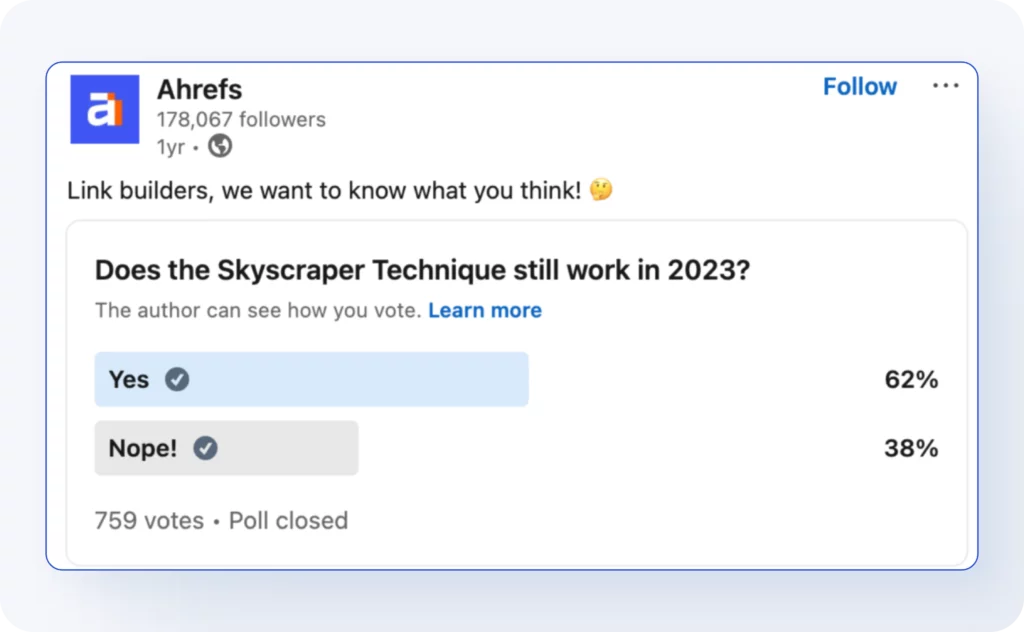
When you think about it, the psychological premise it's based on hasn't changed. As Brian explained in an episode of Tommy Walker's The Cutting Room, it's human nature to be attracted to the best of the best:
It still works relatively well because people are always going to be attracted to the best. There’s always some wow factor with something that’s really comprehensive, really over the top, amazing that they’re more likely to link to and share. And there’s psychological reasons for that that don’t go away after ten years.
However, certain things have changed, and only 6.2% of the experts we interviewed for our State of Link-building Report believed Skyscraper was an effective link-building strategy in 2024.
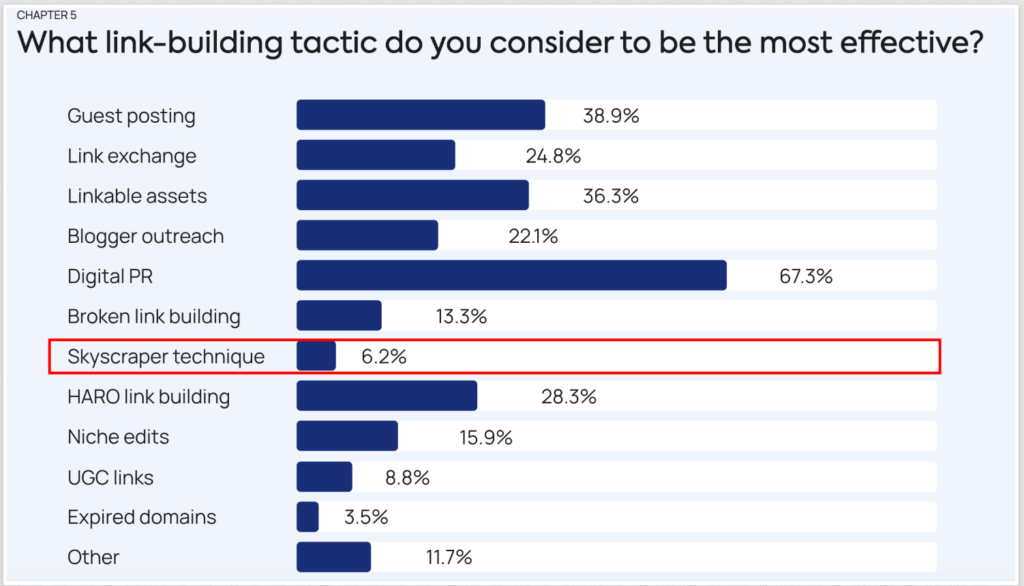
One thing that often comes up is that people need an incentive to link to your content, no matter how good it is.
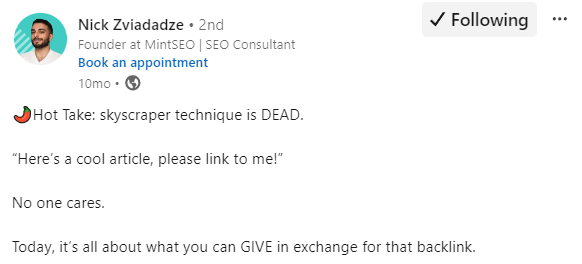
Mark Mars of Niche Website Builders talked about the changing expectations back in 2020:
When I was first doing it two years ago, I happily say that you get 70 or 80% they’ve linked in the home niche for free just because they like the content enough… In the last couple of years… people are just more savvy. They know a link’s got value, it’s worth something, and we’ll want you to pay for it.
Elena Dyulergova, the Senior SEO at Scalerrs, who used the Skyscraper tactic in 2021, was able to get only about 5% of links for free:
The purpose of the skyscraper is to obtain links for free, so even though I did obtain plenty of links, they were 95% paid. So, I suppose this would be classified as not successful.
Another thing that's making Skyscraper link-building harder these days is content saturation. It's easier than ever to create tons of content on any imaginable topic. And the tactic is well-known now, so everybody is trying to create Skyscraper content by default.
This makes it difficult for your content to stand out and stay on the top, especially if you're only starting to build your audience.
Brian himself mentioned it in an episode of Search Live Talk (2018):
It’s not 2007 anymore. You have to promote your stuff or else people aren’t going to see it. There’s just too much content out there already, especially if you don’t have an audience already. You have to work ten times harder to get the word out about your content.
This takes us to the next point: Established brands, like Semrush, will find it much easier to get lots of backlinks organically. Neil Patel will get way more responses to his emails than an average outreach specialist or blogger. So, the tactic might still work for them, but not necessarily for the majority of creators and SEOs out there.
Overall, the tactic may still work for certain content types, but it requires more footwork, and the ROI is likely to be less spectacular than in the early days.
Step-by-Step Guide How to Use Skyscraper Technique
If you're not discouraged and think the Skyscraper method is worth trying, here's our step-by-step guide on how to execute the strategy and increase your success chances.
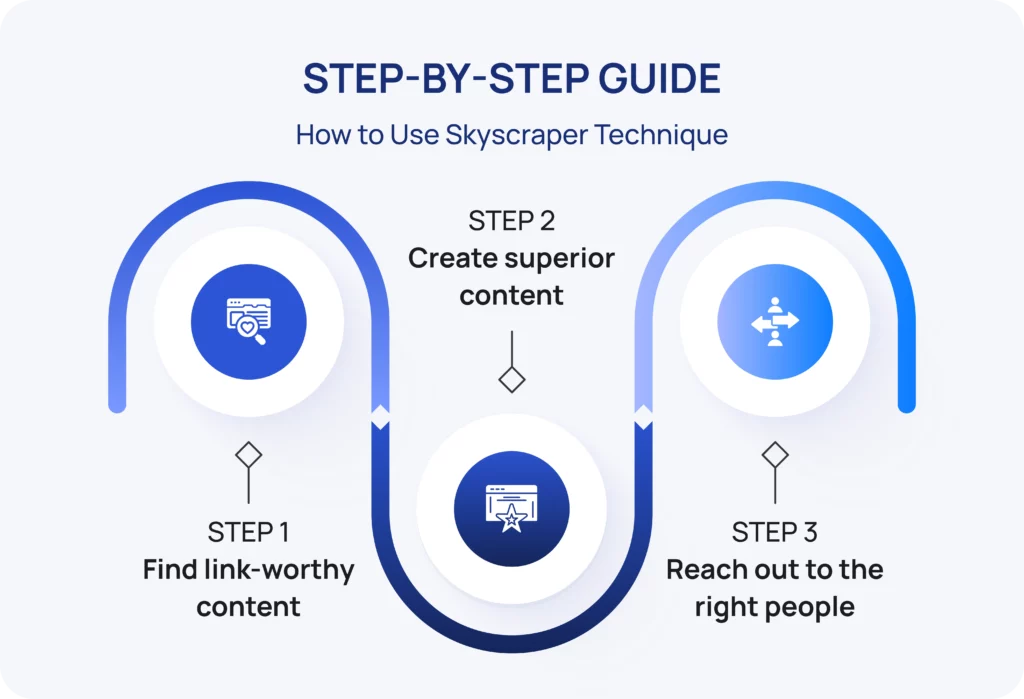
Step 1: Find link-worthy content
The first step in the process is finding popular content relevant to your niche that a) has lots of links you could inherit and b) you can improve dramatically. I stress the word 'dramatically' because marginal improvement won't cut it.
What type of content works best for the Skyscraper technique?
Look for:
- How-to/comprehensive/complete/buying guides
- Templates
- Review posts
- Listicles
- Question posts
- Infographics
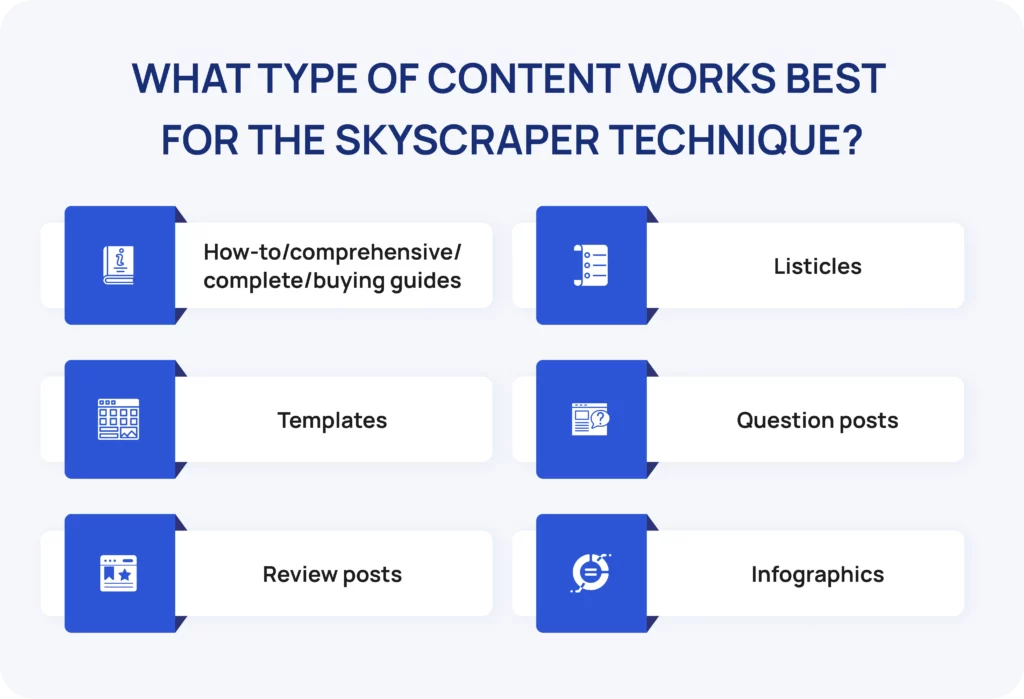
There are 2 ways to do it.
Competitor analysis
The easiest way to find content that attracts links is by spying on your competitors.
Here's how to do it in Ahrefs Site Explorer (Semrush's Backlink Analytics tool offers similar capabilities):
In Site Explorer, navigate to the Best by links report. Here's what it looks like for one of our competitors, uSERP.
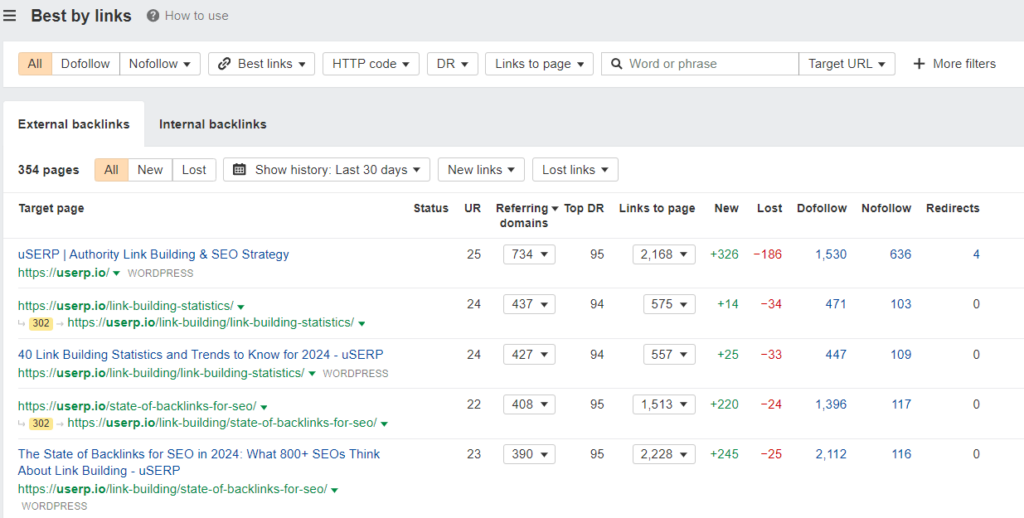
You can see that the 2 resources with the most backlinks are about Link-building Stats and their State of Backlinks report. That's the kind of content you need to replicate and improve on. And that's exactly what we did with our State of Link-Building report.
Target keyword research
Another way is by searching for content in your niche. Which you can do in Content Explorer.
Here's how:
- Search for the target keyword in the title.
- Set the filter to DR: 50+, Referring domains: 100+, Page traffic: 1K.
- Exclude homepages.
- Skim the results for content that you can work with.
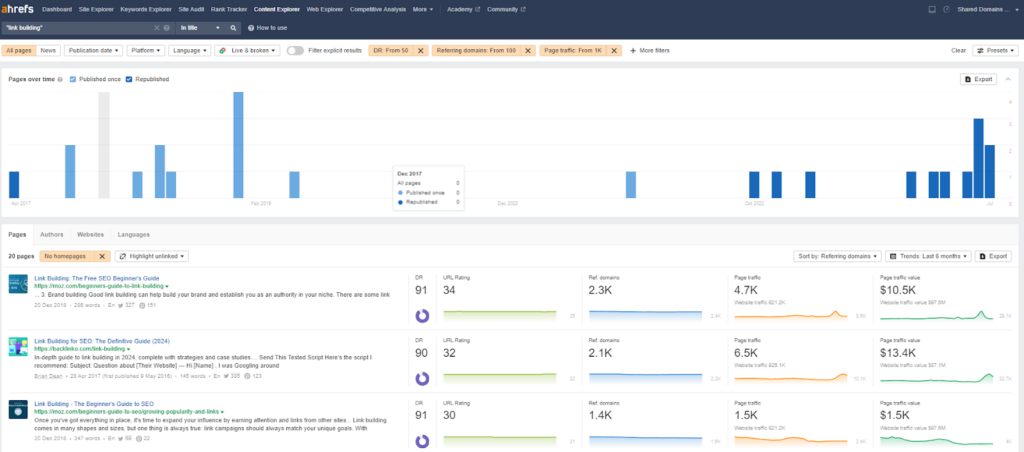
Step 2: Create superior content
The next step is creating content that delivers more punch than the existing articles.
You can achieve it in a few ways:
- Make it longer and more comprehensive: If the best article covers 10 strategies, write about 11. If it's about 13, make it 15. You probably know where this is going, though: there will always be someone who can write a longer piece and cover more aspects. Which doesn't necessarily mean more value. So be reasonable and curate the content, focusing on quality.
Now, of course, it can get ridiculous. Like if there’s something that has 100 tips, you create 500 tips, and then it’s just stupid at that point, actually doesn’t add any value
- Add new insights: Adding original data or expert quotes is a much more sustainable way to enhance your content. And they're much more challenging to copy, which makes it more difficult to dethrone such content.
- Bring it up to date: Updating the existing content, for example, by adding current statistics or covering new trends, is the easiest way to create successful content for your Skyscraper campaigns.
- Improve page design: Making your website faster and optimizing it for various devices improves the user experience and increases visitor engagement with the content (and translates into better performance in SERPs).
- Add visuals: Infographics, images, and videos to make the content more engaging, easier to digest, and aesthetically pleasing. Such content is more likely to be shared and go viral too.
- Showcase your credibility: Don't be shy to showcase your experience and subject expertise. It establishes your authority and demonstrates that the content is trustworthy.
- Optimize for search: Robust search engine optimization will make your content easier to find and will give you a competitive edge. Use a content optimization tool like Surfer or Scalenut. Which I'm using to optimize this article.
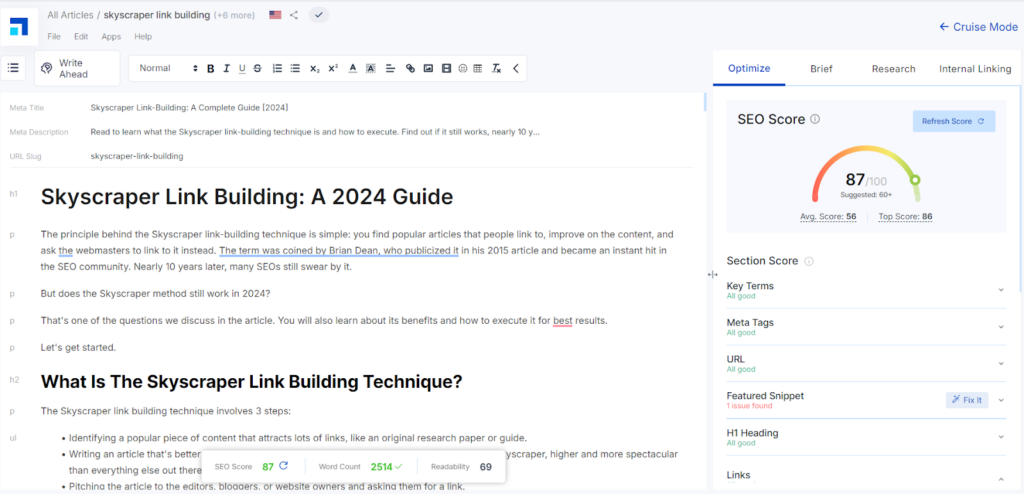
- Nail the search intent: writing a similar article to those ranking in SERPs is often enough to rank but the search intent of your keywords may change over time. So don't copy the original content format blindly. Try to put yourself in the mind of the searcher to figure out what kind of content they might be looking for. If you guess it, you might hit a jackpot. Or it might be a complete flop, no matter how many backlinks you get.
Step 3: Reach out to the right people
Creating great content isn't enough to gain links—it hasn't been for a while. So, the final step in the Skyscraper process is promoting your content via email outreach.
Find prospects
Prospecting is the extension of the process you used to find linkable content to replicate:
1) In the Best by links report in Ahrefs, click on the number of referring domains. This opens a window listing all referring domains. Click Open in a new tab for convenience.

2) Set the filters for Dofollow links, DR30-70, and traffic 1K+.
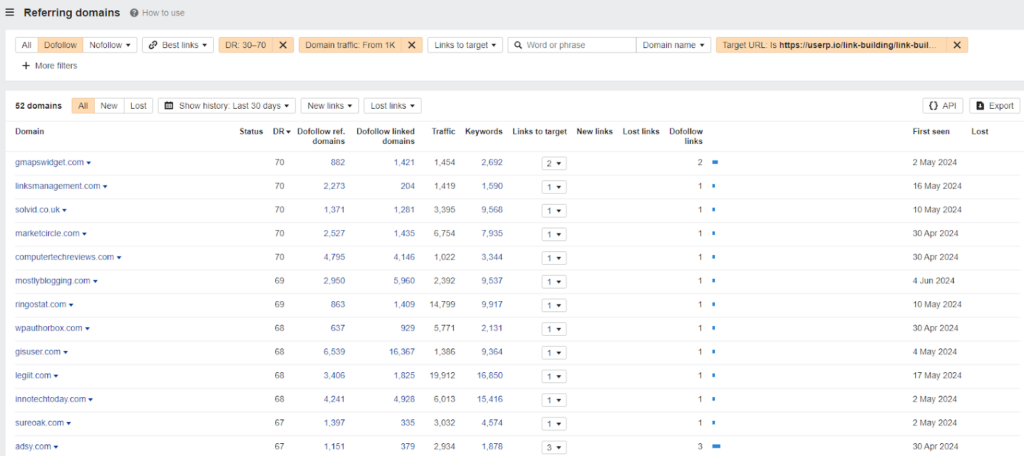
3) Click Links to target to display the pages that link to the content.
4) Visit each of the pages, evaluate their quality, and assess your chances of securing the link.
Here are some questions that can help:
- Is the page up to date?
- Can your link serve the same purpose more effectively?
- Would including a link to your site cause any conflict of interest?
- Is there any existing relationship between the two sites?
- Is updating the link a complex or time-consuming task?
- Are they likely to include the link for free? If not, can you afford it?
Let's be honest: link building is about volume. The more outreach emails you send, the more backlinks you get.
The catch is that you won't have enough prospects if you limit yourself to the pages linking to the original article. Instead, target all the pages linking to all the articles ranking for the relevant keywords.
You can find them via the Ahrefs Keywords Explorer: search for the keyword and scroll down to the SERP overview. Check out the Domains column for all the websites linking to the articles.
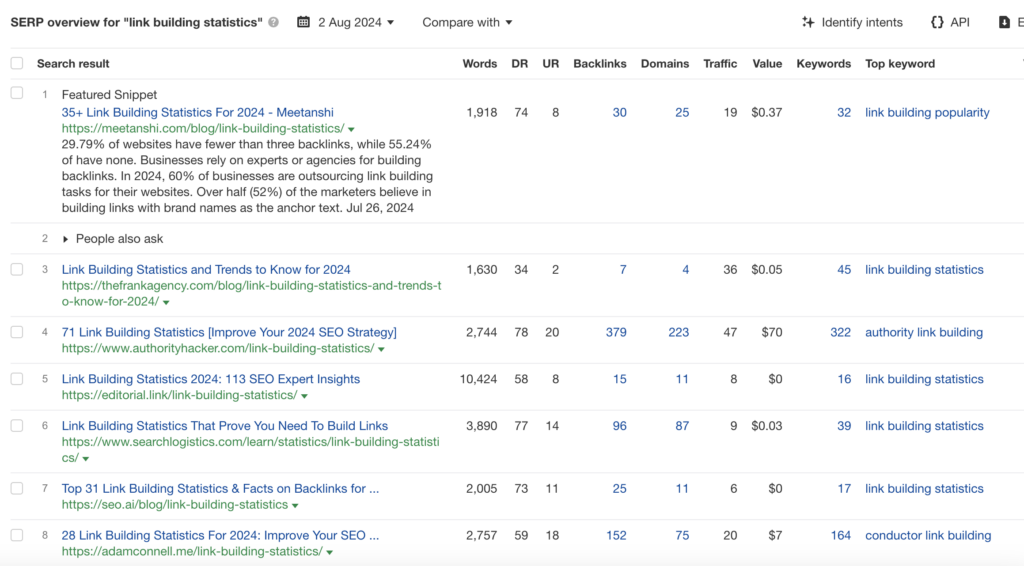
Segment your prospects
Pages may link to the content you're trying to replace for different reasons. For example, they find different statistics or sections of the text relevant.
Identifying the reason and segmenting users can increase the effectiveness of your outreach efforts.
A quick way to do it is by looking at the anchor texts used in the linking articles, which you can find in the Anchors report.
Below, you can see that pages refer to specific numbers, like 69% or 92%. Check what the figures refer to, and if you have more current data in your article, you can mention it in the outreach email to make it more relevant. And increase your success rate.
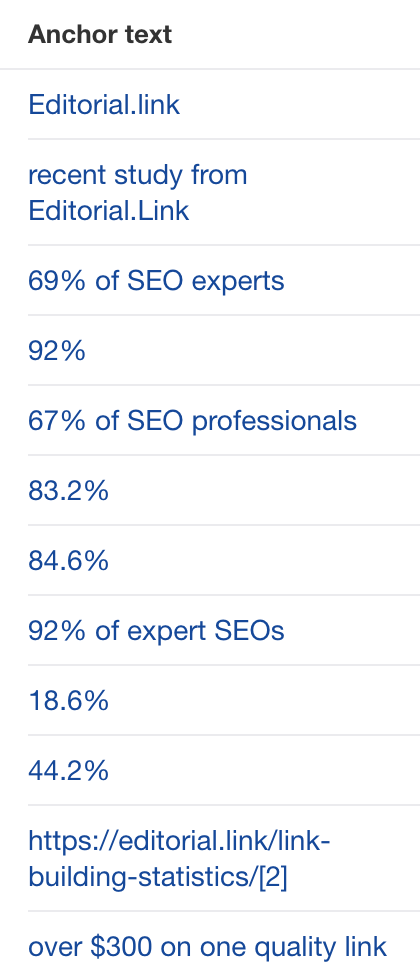
Find their contact details
Once you have the list of prospective websites to target, it's time to find their contact details.
Do you want to do it the easy way or the effective way?
The easy way would be through the contact forms and 'Contact us' sections. This may work for smaller sites, where the webmaster also has editorial control of the content.
For larger organisations, try a more targeted approach and look for the decision-makers.
Use LinkedIn. Search for the company and head to the People tab. Search for content-related roles: SEO and marketing managers, and editors.
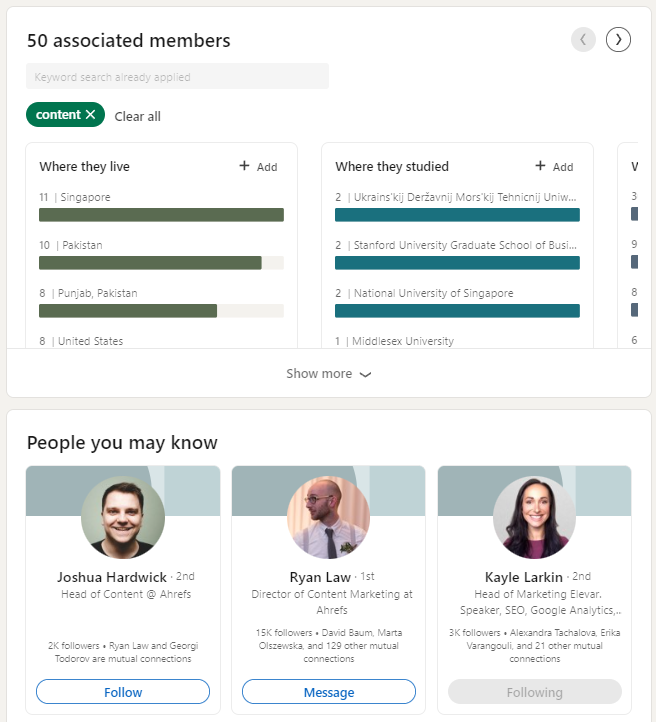
There's nothing wrong with messaging them directly via LinkedIn. However, don't rush it. Start following their account and engaging with their content to create a foundation for a future relationship.
If you prefer contacting them via email, you can find their details using an outreach tool like Hunter.io. Which also allows you to save the prospects, segment them, and create personalized campaigns.

Compose the right message
Let's face it: Webmasters have been getting flooded with emails based on the template developed by Brian Dean for years now. And as a result, they usually ignore them.
The solution?
Develop your own templates and test them. In the email, focus on highlighting the benefits of adding the link to your site. Here's one such template developed by Antonio Gabric, the outreach manager at Hunter.io.
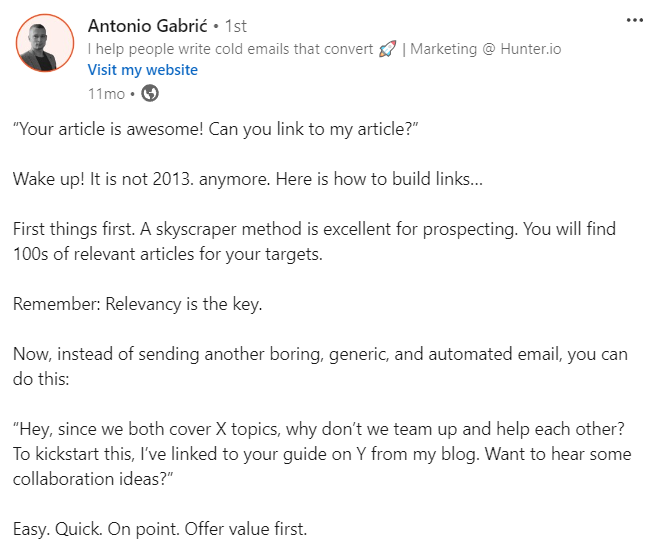
As you've got about 9 seconds to capture the attention of the reader, here are a few more things you can do to increase your outreach success rate:
- Get straight to the point;
- Don't write more than 100 words;
- Write 1-2 sentences per paragraph;
- Use lots of white space.
Follow up
You can increase the response rates considerably by creating sequences of emails. Woodpecker data shows that sending 1-3 emails will get you a 9% response rate, and you can triple it by sending 4-7 emails.
Bear in mind, though, that longer sequences increase the risk of getting labeled as a spammer.
And sending good follow-up emails requires considerably more effort. It's not enough to regurgitate the same message again and again. Gradually build up on the previous ones and add value. For example, by highlighting the benefits you haven't mentioned before.
So 2-3 follow-ups might be a good balance.
Final Thoughts
Although immensely popular and successful to start with, the Skyscraper link-building technique isn't likely to bring you tons of backlinks anymore. Not for free, anyway. It might work for well-established brands that have the capacity to create excellent content at scale.
If you're only starting to build your authority, it's much more difficult to break through. Every link builder knows the importance of creating high-quality content, so standing out is a challenge. And you have to do way more work to get your content in front of other people. And when you do, expect to be asked for money.
In this context, the Skyscraper method may not be the best link building strategy, and you shouldn't rely on it exclusively. A comprehensive SEO strategy based on multiple tactics and tailored to your unique needs will generate better results.
Need help with that? Get in touch with the Editorial.Link and will sort you out!




